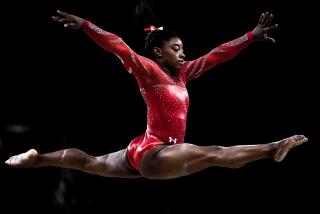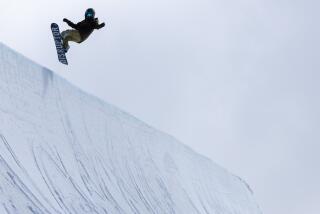ALPINE SKIING
The four Olympic alpine disciplines, particularly the downhill, usually attract the largest crowds and television audiences. The slalom and giant slalom are considered technical events; the super-giant slalom and downhill are tests of speed and daring.
People to Watch
Women’s events will be led by Germany’s superstar speed racer Katja Seizinger, the defending Olympic downhill champion, along with Hilde Gerg and Martina Ertl. The Austrian men were downright dominating heading into the new year, having won 13 of the first 19 World Cup races.
With Americans Hilary Lindh retired and Picabo Street on the mend, the U.S. women’s medal chances appeared bleak until the sudden rise of Kristina Koznick, a U.S. team veteran whose career had been derailed by a series of frustrating injuries--knee, frostbitten toes, back.
Finally injury-free, the 22-year-old slalom specialist from Burnsville, Minn., has enjoyed a breakthrough season on the World Cup circuit, posting a string of top-10 slalom finishes, including her first podium finish, a second at Lienz, Austria, in December.
Inside Info
Can three 1994 medalists returning after injuries recapture Olympic glory?
Americ’s Tommy Moe, defending downhill champion, and Picabo Street, defending silver medalist in downhill, are rebounding from serious knee injuries since 1994 in Lillehammer. Also, status of Sweden’s Pernilla Wiberg, 1997 World Cup overall champion and 1994 Olympic gold-medal winner in combined, is in doubt because of broken ribs. This will no doubt be the last Olympic schuss for the great Alberto Tomba, a five-time medalist, but the most sure-shot favorite for Nagano gold is another Italian, Deborah Compagnoni, who has dominated giant slalom competition. Compagnoni is the reigning Olympic and world champion in the event and was unbeatable in early World Cup competition this season.
Equipment
* Poles
Downhill: Curved to hug the body and reduce air resistance
Slalom: Straight
* Skis
Downhill: Longer than those for slalom. Some downhillers are using parabolic, or side-cut skis to enhance turning ability. These are wider at the tips and tails, like an hourglass.
Slalom: Shorter, more flexible skis with sidecuts that allow quick, precise turns.
* Boots
Downhill: Inclined at the ankle and raised to avoid contact with the snow
Slalom: Must have lateral flexibility
* Helmet required
* Protective gear: Padding worn under ski suit to protect spine and lower back
MEN’S DOWNHILL COURSE
The 3,280-meter run combines aggressive jumps with tight high-speed turns.
1. Alpine Jump: 250 meters into race, skiers may fly 70 meters from this largest jump
2. Rabbit Traverse: Racers need to maintain a line
3. Gondola Station: High-speed turn
4. Panorama Line: Series of tight turns
5. Russi ’98 Jump: 1,700 meters into race, skiers may fly 50 meters
6. Adam’s Bowl: High-speed turn
7. Vacuum Tube: Course becomes narrow, racers faced with series of turns at high speed
8. Kamoshika Jump: Racers may fly 60 meters before finishing down the steepest part of slope
SPEED EVENTS
Downhill and Super G
Location: Happo’one Ski Area in Hakuba
Starting order: Determined by skiers’ worldwide ranking, except for the top 15 competitors, whose starting order is determined by draw.
Winner: Determined after one run, usually by hundredths of a second
DOWNHILL
Considered to be the most glamorous alpine event because if its speed and danger. Skiers make their way down a steep course that includes jumps and high-speed turns
Verticle drop
* Men: 840 meters
* Women: 781 meters
Length
* Men: 3,280 meters
* Women: 2,653 meters
*
SUPER GIANT SLALOM (Super G)
Skiers maneuver through series of gates, requiring long, sustained turns at high speeds. Both feet (skis) must pass through each gate.
Verticle drop
* Men: 660 meters
* Women: 587 meters
Gates
* Men: minimum of 35
* Women: minimum of 30
Length
* Men: 2,423 meters
* Women: 2,080 meters
TECHNICAL EVENTS: Slalom and Giant Slalom
Location: Shiga Kogen, Yamanouchi Town
Winner: Determined after two runs by the fastest combined times.
Starting order: Determined for the second run by standings achieved in the first run. If course is in good condition, the order of the top 30 skiers is reversed.
SLALOM
Gates placed close together, forcing skier to make quick, sharp turns down the course. Gates: Marked by plastic poles equipped with a spring. When hit, pole tilts over, but does not bounce back and hit skier. Both feet (skis) must pass through gate, but body can swing outside the pole.
Course Length
* Men: 607 meters
* Women: 530 meters
Verticle drop
* Men: 220 meters
* Women: 200 meters
Gates
* Men: 55-75
* Women: 45-65
GIANT SLALOM
Gates placed further apart, requiring graceful, arcing turns at faster speeds.
Course Length
* Men: 1,487 meters
* Women: 1,329 meters
Verticle drop
* Men: 660 meters
* Women: 587 meters
Gates
* Men: 53-66
* Women: 47-59
COMBINED
Skiers will compete in a downhill race one day, followed by a slalom race the next. Both courses are shorter than for individual downhill and slalom events. Winner determined by the best combined time.
Gate Technique
Races must stay within gates throughout race to avoid disqualification.
Open: Poles aligned horizontally along the slope.
4-6 m
Closed: Poles aligned vertically
Hairpin:
Racers have to complete a closed gate- open gate- closed gate combination
Flush:
This tough sequence requires racer to negotiate three straight closed gates set along fall line of the course.
Source: Nagano Olympic Organizing Committee, U.S. Ski and Snowboard Assn., Associated Press; Researched by JANICE L. JONES and MIKE JAMES / Los Angeles Times
More to Read
Go beyond the scoreboard
Get the latest on L.A.'s teams in the daily Sports Report newsletter.
You may occasionally receive promotional content from the Los Angeles Times.






